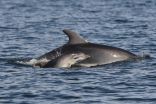(Press-News.org) The rise in tourism, fishing and sea transport between the Iberian Peninsula and the Balearic Islands is compromising the wellbeing of a small population of common bottlenose dolphins living in coastal waters off the Pityusic Islands. This is the conclusion of a study led by the University of Barcelona (Spain), which has, for the first time, counted these mammals in summer and spring, which are crucial seasons for them.
Despite being one of the most common cetaceans in the Mediterranean Ocean, the common bottlenose dolphin (Tursiops truncatus) resides in areas close to human beings, and is thus subject to continual conflicts - so much so that in 2006, the International Union for Conservation of Nature (IUCN) declared the subpopulation of this species in the Mediterranean 'vulnerable' after it had decreased by 30% in the preceding 60 years.
As Joan Gonzalvo, a scientist at the University of Barcelona's (UB) Institute for Research on Biodiversity, explains to SINC: "Anthropogenic activities such as fishing, coastal development, tourism and maritime transport, especially in summer, are some of the threats faced by dolphins in the Balearic Islands."
Gonzalvo is the main author of a study that evaluated the abundance of these cetaceans over three years, as well as movement patterns between the islands and their group dynamic. The results, published in the 'Journal of the Marine Biological Association of the United Kingdom', estimates that there are 517 dolphins inhabiting this area of the Mediterranean.
The Pityusic Islands are considered a refuge for marine species, especially this population of bottlenose dolphins - probably one of the largest in Spain. However, the study demonstrates that the total number of these sea mammals is smaller than previously thought. "It may not be more than a few hundred," the researcher says.
The team drew up a series of dolphin distribution maps based on sightings between 2002 and 2004. "Most sightings were in summer and spring, when the dolphins could have been avoiding coastal waters due to the growing number of boats and ships and greater human presence," Gonzalvo reasons.
Danger point
The high degree of loyalty dolphins show to their habitat and relatively limited mobility across the archipelago forces them to reside in an area where overfishing, habitat degradation, tourist boat disturbance and an ever-growing fishing industry are a modern-day reality.
According to previous studies, conflicts with fishers cause 30 to 60 dolphin deaths a year in the area. "The animals play around the nets to take the caught fish and risk getting trapped," the scientist comments. Additionally, in order to avoid loss of fishing profits, fishers take drastic measures; attacks on dolphins - and even dolphin deaths - are common.
The Balearic Islands have over 400 handcrafted boats, more than 60 trawlers, three longline fishing boats and 11 seiners, so interaction with dolphins is common. But fishing is not the only threat.
Sea traffic has increased considerably in the archipelago. According to the Tourism Council for the Balearic Islands, 69 ports currently offer 20,488 anchoring spots over the islands.
Crashing into boats
The risk of boats and ships colliding with dolphins and noise disturbance from maritime traffic - which affects the behaviour of these mammals - have become a cause for concern.
Added to this is the pollution, which is higher than in other areas. "The concentrations of organochlorine compounds found in these dolphins are very high, even more so than in any other dolphin species," Gonzalvo highlights, adding that the concentrations vastly exceed accepted limits for mammals.
For all these reasons, the researchers call for urgent action in terms of managing sustainable fishing, mitigating interaction between fishers and dolphins, prevention of sea pollution and controlling tourism - especially boat and ship traffic - to ensure the preservation of this fragile population of bottlenose dolphins. "Conservation measures are needed beyond those already in place," he concludes.
INFORMATION:
Reference:
Joan Gonzalvo et al. "Strong site-fidelity increases vulnerability of common bottlenose dolphins Tursiops truncatus in a mass tourism destination in the western Mediterranean Sea" Journal of the Marine Biological Association of the United Kingdom 94(6):1227-1235 (2014)
The drive for energy efficient homes could increase asthma risks, according to new research.
Led by a team at the University of Exeter Medical School, the research has found that a failure by residents to heat and ventilate retrofitted properties could lead to more people developing the respiratory condition.
Working with leading UK social housing provider, Coastline Housing, the research team assessed data from the residents of 700 properties in Cornwall. They found that people living in more energy efficient homes had a greater risk of asthma, and that the presence ...
Scientists at Brunel University London have found a way of targeting hard-to-reach cancers and degenerative diseases using nanoparticles, but without causing the damaging side effects the treatment normally brings.
In a huge step forward in the use of nanomedicine, the research helped discover proteins in the blood that disguise nanoparticles so they are absorbed into cells without causing inflammation and destroying healthy cells.
Two studies, Complement activation by carbon nanotubes and its influence on the phagocytosis and cytokine response by macrophages and Complement ...
The preventive effect of breast cancer drug 'tamoxifen' remains virtually constant for at least 20 years - with rates reduced by around 30 per cent - new analysis published in The Lancet Oncology reveals.
The IBIS-I trial (International Breast Cancer Intervention Study), led by Queen Mary University of London and funded by Cancer Research UK, examined the long-term risks and benefits of taking tamoxifen to prevent breast cancer in women at high risk of the disease (aged 35-70 years old, primarily with a family history of breast cancer).
During the study* 7,154 pre ...
Smart agricultural practices and an extensive grain-trade network enabled the Romans to thrive in the water-limited environment of the Mediterranean, a new study shows. But the stable food supply brought about by these measures promoted population growth and urbanisation, pushing the Empire closer to the limits of its food resources. The research, by an international team of hydrologists and Roman historians, is published today in Hydrology and Earth System Sciences, an open access journal of the European Geosciences Union (EGU).
Stretching over three continents and persisting ...
Phoenix, AZ (December 11th, 2014) - Signs of cognitive decline related to aging populations, and even the severe cognitive losses seen in Alzheimer's disease and neurodegenerative disorders, may emerge many years earlier, according to a report presented today at the American College of Neuropsychopharmacology annual meeting in Phoenix (Arizona). The study suggests that early signs of cognitive decline are already present for some individuals during midlife, and that they are linked with risk factors such as elevated blood pressure. It is possible that if these risk factors ...
December 11, 2014--(BRONX, NY)--Sleep-related breathing problems and chronic lack of sleep may each double the risk of a child becoming obese by age 15, according to new research from Albert Einstein College of Medicine of Yeshiva University. The good news is that both sleep problems can be corrected. The study, which followed nearly 2,000 children for 15 years, published online today in The Journal of Pediatrics.
"In recent years, lack of sleep has become a well-recognized risk for childhood obesity," said Karen Bonuck, Ph.D., professor of family and social medicine ...
WASHINGTON, DC (December 11, 2014)--A new study led by a researcher at Milken Institute School of Public Health (Milken Institute SPH) at the George Washington University looks at the metal cadmium and finds that higher human exposure can lead to significantly shorter telomeres, bits of DNA at the ends of chromosomes that are associated with cardiovascular disease, diabetes and other diseases of old age. The study, which was published online today in the American Journal of Epidemiology, is the largest-ever to look at cadmium exposure and telomeres.
"We looked at heavy ...
TORONTO, Dec. 11, 2014 -- Nearly seventeen per cent of adults surveyed in Ontario said they have suffered a traumatic brain injury that left them unconscious for five minutes or required them to be hospitalized overnight, according to new research. These same adults also reported more substance use, smoking and recent psychiatric distress.
Researchers compared the prevalence of reported TBI with current substance use, cigarette smoking and psychological distress among 1,999 Ontario adults.
"We found that one in six Ontario adults reported a history of TBI," said Dr. ...
Novel research reveals that the risk of acute gout attacks is more than two times higher during the night or early morning hours than it is in the daytime. The study published in Arthritis & Rheumatology, a journal of the American College of Rheumatology (ACR), confirms that nocturnal attacks persist even among those who did not consume alcohol and had a low amount of purine intake during the 24 hours prior to the gout attack.
The body produces uric acid from the process of breaking down purines--natural substances in cells in the body and in most foods--with especially ...
New research suggests that toddlers who share a bed with their parents might have an increased risk of asthma in later childhood.
The study, which is published online today (11 December, 2014) in the European Respiratory Journal, sheds light on the potential health effects of bed-sharing for infants and toddlers.
The researchers investigated 6,160 mothers and their children in Rotterdam, the Netherlands. They collected information via a questionnaire on wheezing and asthma symptoms every year from the age of one to six years. They also assessed sleeping patterns at ...

